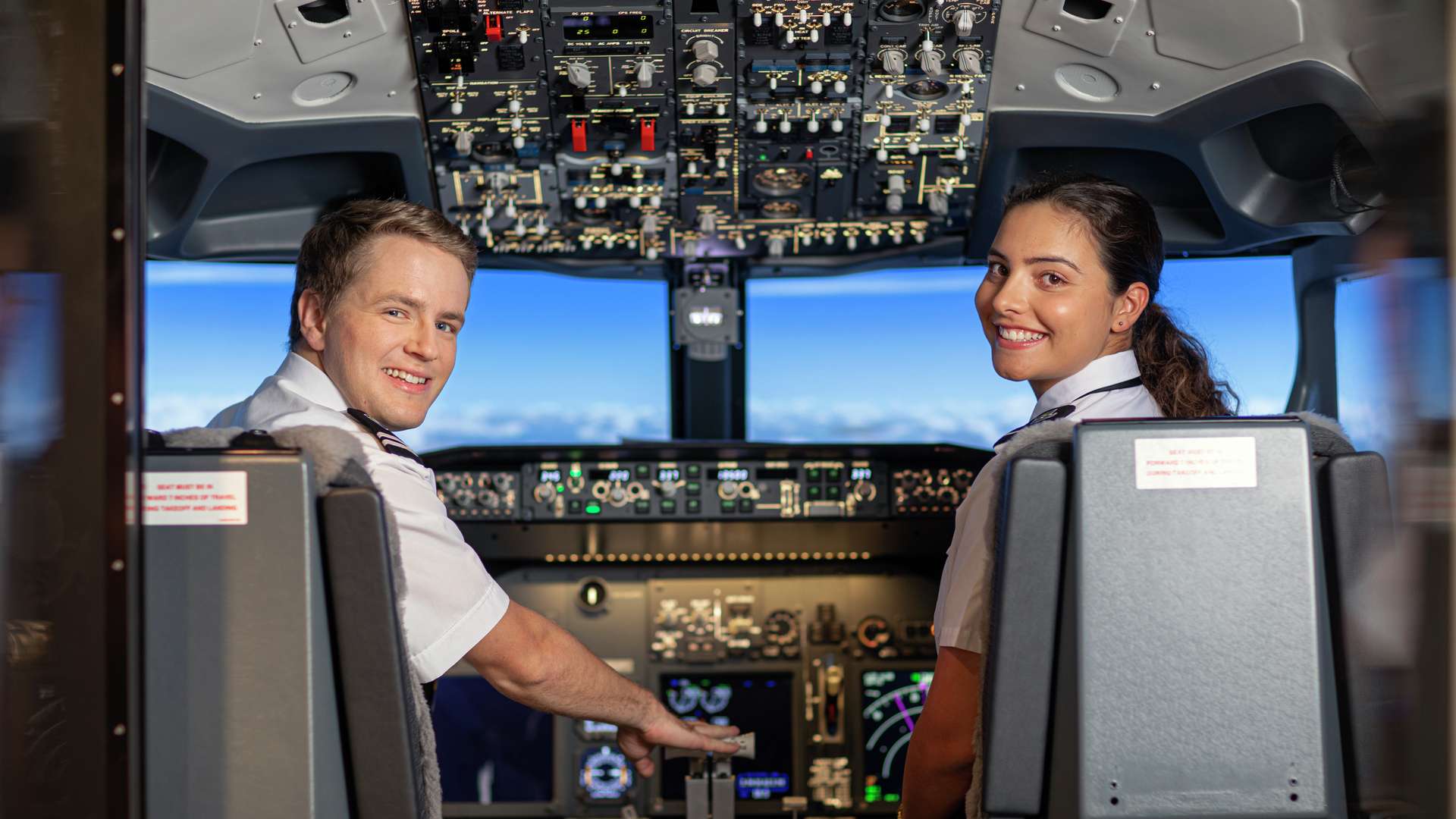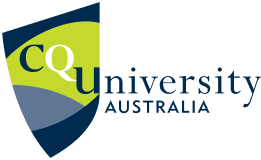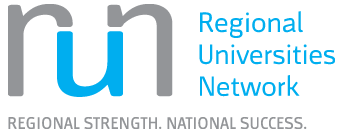| Duration | 3 years full-time |
| Location | Cairns |
| Next start term | Term 1, 2025 |
| Study mode | On Campus |
| Course code | CL29 |
| CRICOS | 097033M |
| First-year fee | A$41,040 (Indicative) |

Overview
If your career aspiration is to become a professional commercial airline pilot capable of managing a multi-crew environment, then the Bachelor of Aviation (Commercial Pilot) will prepare you for this. The degree will provide you with the knowledge, skills and experience to satisfy the requirements for a Commercial Pilot Licence and Command Instrument Rating, and to become a commercial pilot.
The Bachelor of Aviation (Commercial Pilot) will be packaged with a Test of English for Aviation Preparation course.
The Bachelor of Aviation (Commercial Pilot) will prepare you for a career as a commercial pilot. In this course, you will gain the aeronautical knowledge and experience required to achieve a Commercial Pilot License, Multi-Engine, and Command Instrument Rating.
In the first term of your study, you will prepare for flight training by learning about the aviation industry, the fundamentals of flight, and aviation safety. In your second term, you will begin your flight training and start Commercial Pilot License (CPL) theory coursework.
During your second year of study, you will continue fight training and CPL theory coursework, as well as undertaking more advanced theory courses in human factors and safety.
During your third year, you will complete your flight training and achieve a Commercial Pilot License and Multi Engine Command Instrument Rating. You will also fly the 737NG simulator and undertake a capstone Aviation Project that will provide you with the opportunity to showcase your knowledge and analytical skills through the presentation of a research project on an approved aviation-related topic.
Career Opportunities
When you graduate with the Bachelor of Aviation (Commercial Pilot) you will meet the aeronautical knowledge and experience requirements for careers as a commercial pilot in the air transportation industry. You would normally be legally qualified to work as a commercial pilot and have access to aviation careers in the air transportation industry, or a cadetship/ traineeship offered by some airlines. With additional flight training, you can explore opportunities in general aviation such as; flight instructing, tourism operations and agricultural operations such as mustering and crop spraying.
Structure & Availability
COURSE STRUCTURE
You are required to complete a total of 19 core units.
Compulsory units
- Introduction to Aviation
- Flight Fundamentals
- Aviation Safety Fundamentals
- Introduction to Flight Operations
- Commercial Pilot Licence Air Law
- Commercial Pilot Licence Human Factors
- Aeronautical Flight Practice 1
- Aeronautical Flight Practice 2
Compulsory intermediate and advanced units
- Commercial Pilot Licence Aerodynamics & Aircraft General Knowledge
- General Aeronautical Knowledge (Commercial Pilot Licence)
- Commercial Pilot Licence Meteorology
- Commercial Pilot Licence Navigation
- Commercial Pilot Licence Flight Planning
- Advanced Human Factors
- Applied Safety Management Systems
- Aeronautical Flight Practice 3
- Aeronautical Flight Practice 4
- Advanced Aeronautical Flight Practice 1
- Advanced Aeronautical Flight Practice 2
- Advanced Aeronautical Flight Practice 3
- Multi Crew Cooperation
- Aviation Capstone Project
|
Licence Type |
Flight Experience | |
| First Year | Fly solo in the circuit area and training area of the training aerodrome | |
| Second Year (First Half) | Recreational Pilot Licence | Fly a single-engine aircraft within 40km of the airfield |
| Second Year (Second Half) | Private Pilot Licence | Start your navigation training and visit multiple aerodromes in regional and outback Australia |
| Third Year | Commercial Pilot Licence and Multi-Engine Command Instrument Rating | Accumulate 100 hours of Pilot In Command (PIC) flight experience |
UNIT INFORMATION
For information on the units, you could study as part of this course, visit the Handbook and select the "Course Structure" tab.
CREDIT TRANSFER INFORMATION
If you have already completed study relevant to the course you have enrolled in, and able to supply a logbook for review, we will be able to undertake a competency assessment for evaluation.
UNIT INFORMATION
For information on the units, you could study as part of this course, visit the Handbook and select the "Course Structure" tab.
CREDIT TRANSFER INFORMATION
If you have already completed study relevant to the course you have enrolled in, and able to supply a logbook for review, we will be able to undertake a competency assessment for evaluation.
On-Campus Availability
| Intake | Locations |
|---|---|
| Term 1, 2024 | Cairns |
| Term 1, 2025 | Cairns |
Not applicable.
Multi Crew Cooperation - AVAT13013
In the third year, AVAT13013 includes flight training in a CASA-approved simulator. AVAT13013 provides the students with the “Certificate of Completion -Multi-Crew Cooperation” for successful completion of all training requirements prescribed in the Aviation Australia Multi Crew Cooperation (MCC) course pursuant to Part 61 and Part 142 of the Civil Aviation Safety Regulations 1988 (CASR).
The course includes flight training of up to 227.3 hours total time (207.3 hours flight time and 20 hours simulator time), 100 hours of pilot in command time and 46 hours of instrument time.
This should be sufficient to obtain your Australian Commercial Pilot Licence (CPL) and a Multi Engine Command Instrument Rating (MECIR).
If you require extra flight hours to reach the required standard for each unit, there will be additional costs, see the Handbook under 'More Details'.
Requirements
Recommended study
Senior English, Physics and Mathematical Methods.
English Language Proficiency Requirements
If you were not born in Australia, Canada, New Zealand, United Kingdom, Ireland, South Africa or United States of America, you are required to meet the English Language Proficiency requirements set by the University.
Applicants are required to provide evidence of completion of:
- A secondary qualification (Year 11 and 12, or equivalent) or
- An Australian Qualifications Framework (AQF) diploma level qualification, or
- Bachelor level qualification study for a period of at least 2 years fulltime with a minimum overall GPA 4.0
completed within Australia, Canada, New Zealand, United Kingdom, South Africa, Ireland, or United States of America, which will meet the English proficiency.
If you do not satisfy any of the above you will need to undertake an English language proficiency test and achieve the following scores as below:
- An International English Language Testing System (IELTS Academic) overall band score of at least 6.0 with a minimum 5.5 in each subset; or
- Test of English as a Foreign Language (TOEFL) - Requires 550 or better overall & minimum TWE score of 4.5 (Paper Based Test), or 75 or better overall and no score less than 17 (Internet Based Test); or
- Pearson Test of English Academic (PTE Academic) - Requires an overall score of 54 with no sub-score less than 46; or
- An Occupational English Test with Grades A or B only in each of the four components.
English test results remain valid for no more than two years between final examination date and the date of commencement of study, and must appear on a single result certificate.
If you are an International student please visit International students English requirements for further information.
Each student will be assessed individually.
Other requirements
Continued enrollment in the course will be conditional on a student passing: a Civil Aviation Safety Authority (CASA) -approved Aviation English Language Proficiency Test; and obtaining a CASA Class 1 Aviation Medical, an Australian Security Identification Card (ASIC) and a CASA issued Aviation Reference Number (ARN), in Term 1 of the first year. These must be obtained at the student's expense. Please visit the CQUniversity international student web pages for additional information.
Students are required to hold a Class 1 Aviation Medical throughout the course.
Students are required to obtain an Australian Security Identification Card (ASIC) before commencing flying.
Students are required to hold the Australian Security Identification Card (ASIC) throughout the course.
Fees & Scholarships
Course fees
This is an approximate cost of enrolling in this course, shown in Australian dollars (A$), for one academic year and is based on a full-time study load (8 units over 2 terms).
The estimated course fee quoted does not include the flight training fee. The flight training costs are determined by the flight training provider, and these costs may be subject to change.
Any additional hours of flight training that you may need to undertake or repeat will be an additional cost – indicative cost of A$500 per hour for single-engine aircraft, A$1000 per hour for twin-engine aircraft (these amounts are subject to change).
Fees are reviewed each year and are subject to change.
Scholarships are not available for this course.
In addition to your international course tuition fees, you must have sufficient funds to cover other study and living expenses.
This will include costs such as textbooks, accommodation, visa applications, Overseas Student Health Cover (OSHC), general living, etc.
How to apply
Our easy to use online application system for international students will guide you through the process of applying for a course at CQUniversity Australia.


